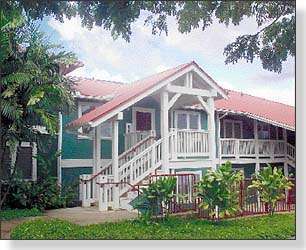The first day, the county received 700 applications The Kaua’i County Housing Agency’s wait list for rental assistance “is fairly short” at just under 400 but hopefully will get longer, according to Helen Brun, county program manager for the federally
The first day, the county received 700 applications
The Kaua’i County Housing Agency’s wait list for rental assistance “is fairly short” at just under 400 but hopefully will get longer, according to Helen Brun, county program manager for the federally funded rental housing assistance program for low-income families and individuals, known as Section 8.
“We’re hoping for at least 1,000” instead of the current 398, she said.
Under the program, federal funds are paid to landlords monthly as portions of the total rent, with the low-income families or individuals still making monthly rental payments to the landlords.
There are around 800 units in the county’s Section 8 rental assistance program, and essentially all of them are occupied by low-income families and individuals.
The wait list for rental assistance for those families making way less than the county’s 2001 median income of $56,500 (as estimated by the U.S. Department of Housing and Urban Development) was reopened to applicants in October 1999 after being closed for some time. The first day, the county received 700 applications, Brun recalled.
The push to add names to the list is fueled by:
– The relatively low number of applicants currently on the list.
– The Housing Agency’s feeling that people aren’t aware that the list is open and don’t know the income limits and other eligibility requirements.
– And because lots of individuals and families on the island might now qualify for the program as a result of the economic downturn since the Sept. 11 terrorist attacks.
Since those with extremely low income – a family of four with a total annual income of less than $19,400, for example – get higher priority, those already on the list and whose work hours may have been cut or who lost jobs should immediately let the Section 8 program know, as they likely would move up on the ever-changing priority list, Brun explained.
“Many people don’t realize that they could qualify for rental assistance. There is a misconception among the general public that the Housing Agency only assists people on welfare, and it’s simply not true,” she said.
Brun said some some people “also think that if they are already in a rental unit, they won’t qualify for assistance. To the contrary, people already in place are just the people we are most able to assist, because they don’t have to go out and locate a unit in a very tight rental market.”
A family of four with a total annual income of less than $32,300 would also qualify for placement on the wait list, but priority goes to extremely low-income families and individuals, she said.
Brun, who has worked for the Section 8 program since it began in 1976 and has been program manager since 1993, has seen many changes in the program.
“At the beginning, when the program first started, it was for low-income. Then it went to very low, and now it’s for extremely low-income families,” she said, noting that 75 percent of new admissions must be the latter.
The program is “geared for the more needy families,” she said.
For more information, please call 241-6440.
Staff Writer Paul C. Curtis can be reached at mailto:pcurtis@pulitzer.net or 245-3681 (ext. 224).


